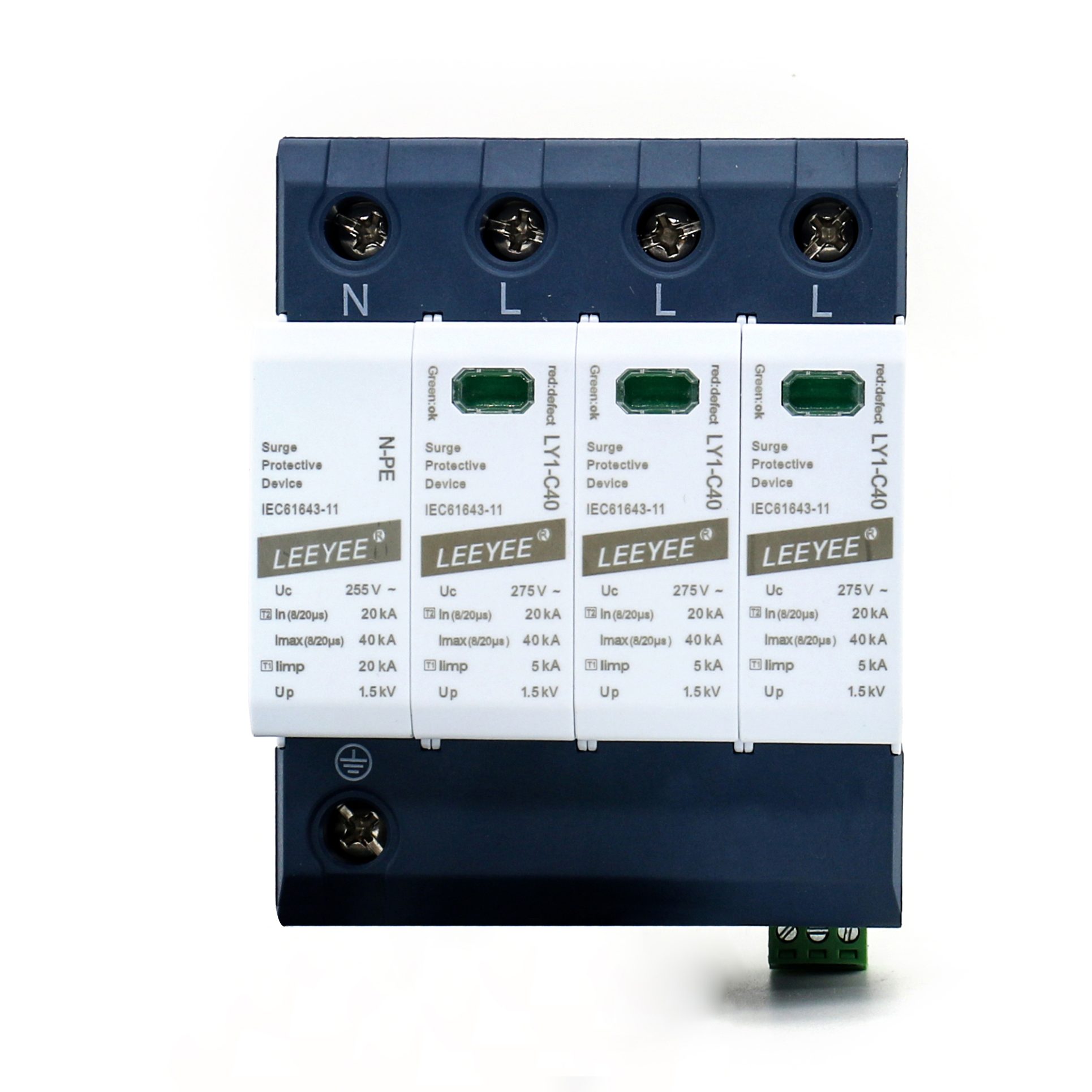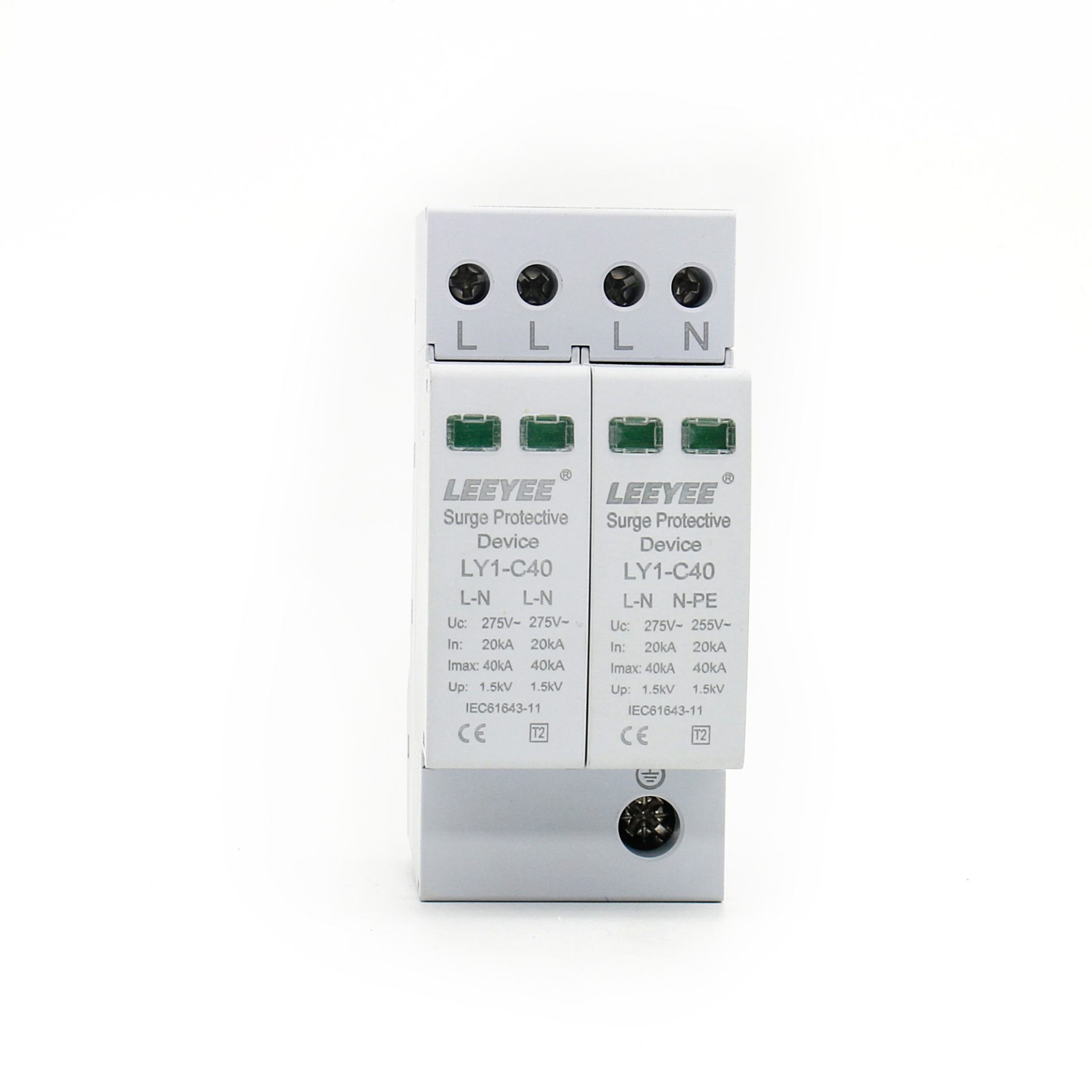Surge Protective Devices (SPDs) are essential components in electrical systems designed to protect equipment from voltage surges. They are categorized into three types based on their installation locations and applications: Type 1, Type 2, and Type 3. Each type serves a specific purpose in protecting electrical systems. Let’s explore these types in detail:
Table of Contents
1. Type 1 SPD
- Definition: Type 1 SPDs are installed at the service entrance of a building, typically located between the utility service and the building’s electrical system.
- Purpose: Designed to protect against external surge events, such as lightning strikes or utility switching operations.
- Installation Location: Generally installed at the main electrical panel or at the point where power enters the building.
- Waveform Handling:
- Waveform: Type 1 devices are typically designed to handle standard surge waveforms, such as the 8/20 µs (microsecond) waveform, which simulates lightning and other transient surge events.
- Energy Handling Capacity:
- Energy Handling Capacity: Type 1 SPDs have a high energy handling capacity, usually rated in kA (kiloamperes). The surge currents they can handle generally range from 40 kA to 200 kA, depending on the model and manufacturer. This high capacity is crucial for safely diverting large surge currents to ground.
- Features:
- Capable of handling high surge currents.
- Typically connected to the grounding system to divert excess voltage away from sensitive equipment.
- Serves as the foundational infrastructure to protect the entire electrical system from external surges.
2. Type 2 SPD
- Definition: Type 2 SPDs are installed downstream of the main service entrance, typically within distribution panels or sub-panels.
- Purpose: Protect against residual surges that may bypass Type 1 SPDs or that are caused by internal sources, such as motor starts or equipment switching.
- Installation Location: Usually placed within the distribution panel to provide protection for branch circuits and critical equipment.
- Waveform Handling:
- Waveform: Similar to Type 1, Type 2 devices also handle 8/20 µs waveforms but may also be designed to manage shorter surge waveforms, such as the 1.2/50 µs waveform, representing switching operations and other transient events.
- Energy Handling Capacity:
- Energy Handling Capacity: Type 2 SPDs typically have a lower energy handling capacity than Type 1 but are still robust, usually rated between 20 kA and 100 kA. They effectively protect against residual surges that may pass through the Type 1 device.
- Features:
- Provides a secondary line of defense against surges.
- Helps mitigate voltage transients affecting sensitive electronic equipment.
- Specifications may vary depending on the equipment they are designed to protect.
3. Type 3 SPD
- Definition: Type 3 SPDs are installed very close to sensitive electronic equipment or devices that require additional protection.
- Purpose: Provide a final level of protection against voltage spikes that may not be fully filtered by upstream devices.
- Installation Location: Often located at the device level, such as near computers, servers, or medical equipment.
- Waveform Handling:
- Waveform: Type 3 devices can also handle 8/20 µs waveforms, but they are specifically designed to filter high-frequency transients and noise that may be present on the power line. They typically handle shorter waveforms to protect sensitive electronics.
- Energy Handling Capacity:
- Energy Handling Capacity: Type 3 SPDs generally have the lowest energy handling capacity among the three types, ranging from 5 kA to 20 kA. Their primary role is to provide final-stage protection for sensitive devices against smaller yet still harmful transients.
- Features:
- Provides localized protection for sensitive devices.
- Enhances the overall protection strategy by absorbing residual surge energy.
- Commonly used in conjunction with Type 1 and Type 2 SPDs for comprehensive surge protection.
Comparison: Type 1 vs Type 2 vs Type 3
| Feature | Type 1 | Type 2 | Type 3 |
|---|---|---|---|
| Installation Location | Service Entrance | Distribution Panel | Point of Use |
| Surge Current Rating | 40 kA to 200 kA | 20 kA to 100 kA | 10 kA to 50 kA |
| Level of Protection | High (External Surges) | Medium (Residual Surges) | Local (Specific Devices) |
| Typical Applications | Main Electrical System | Branch Circuits | Sensitive Equipment |
Which Type of SPD Do You Need? Type 1, Type 2, or Type 3?
Choosing the right Surge Protective Device (SPD) depends on your specific electrical system and the level of protection required. Here’s a guide to help you determine whether you need Type 1, Type 2, Type 3 SPDs, or a combination of them:
1. Type 1 SPD
- When to Use:
- Service Entrance Protection: If you want to protect the entire electrical system from high energy external surges (like lightning or utility switching events), a Type 1 SPD is essential.
- High Surge Exposure: If your building is located in an area prone to severe weather or lightning activity, it is advisable to install a Type 1 SPD at the service entrance.
- Recommendation:
- Use a Type 1 SPD if you want primary protection against external surges and wish to protect the entire electrical system as power enters the building.
2. Type 2 SPD
- When to Use:
- Distribution Panel Protection: If you have sensitive equipment connected to branch circuits or distribution panels, installing Type 2 SPDs is important for protection against residual surges that may penetrate initial protection.
- Internal Surge Mitigation: If your facility has devices that generate internal surges (like motors, HVAC systems, or large appliances), Type 2 SPDs can help protect downstream circuits.
- Recommendation:
- Use a Type 2 SPD if you need secondary protection for specific areas of the electrical system, especially for sensitive electronic devices and branch circuits.
3. Type 3 SPD
- When to Use:
- Point of Use Protection: If you have critical or sensitive electronic devices (like computers, servers, medical equipment, or telecom equipment) that need additional protection, Type 3 SPDs are appropriate.
- Localized Protection: Type 3 SPDs provide a last line of defense against residual transients that may not be fully filtered by Type 1 or Type 2 devices.
- Recommendation:
- Use a Type 3 SPD if you want localized protection for sensitive devices, ensuring that the final layer of protection is in place.
Comprehensive Protection Strategy
For optimal surge protection, consider using a combination of all three types:
- Type 1 SPD at the Service Entrance: Provides the first line of defense against large external surges.
- Type 2 SPD in the Distribution Panel: Protects against residual surges, ensuring branch circuits are safeguarded.
- Type 3 SPD Near Sensitive Equipment: Offers the final layer of protection at the point of connection for sensitive devices.
Important Considerations Before Installing Type 1 and Type 2 SPDs
Before installing Type 1 and Type 2 SPDs, several important considerations and factors must be taken into account to ensure effective protection and compliance. Here’s a comprehensive overview to guide you through the installation process:
Key Considerations
- Understand the Purpose of Each Type:
- Type 1 SPD: Designed for installation at the service entrance to protect the entire electrical system from high-energy external surges.
- Type 2 SPD: Installed downstream in distribution panels to protect sensitive devices and branch circuits from residual surges.
- Type 3 SPD: Typically installed near the power supply for sensitive devices to provide additional protection.
- Check Local Code Compliance:
- Always validate that your installation complies with local electrical codes and standards, such as the National Electrical Code (NEC) in the USA. This ensures safety and legal compliance.
- Choose Appropriate Devices:
- Ensure that the SPDs you select are suitable for your specific application and environment. Check surge current ratings (kA) to ensure they can effectively handle potential surge events.
- Review Manufacturer Guidelines:
- Read and understand the installation instructions and specifications provided by the manufacturer for each SPD, including wiring, grounding, and any specific requirements.
- Proper Grounding:
- Ensure that Type 1, Type 2, and Type 3 SPDs have a solid and low-resistance grounding connection. This is critical for the effective operation of the devices and helps safely dissipate surges to ground.
- Location Considerations:
- Type 1 SPD: Install at the service entrance, typically within the main electrical service panel.
- Type 2 SPD: Install within the distribution panel or sub-panel, connected to sensitive equipment. Consider proximity to the protected devices to minimize surge propagation distance.
- Type 3 SPD: Install near the power supply for sensitive devices to provide the last layer of protection against short-distance surges.
- Plan for Accessibility:
- Ensure that the SPD is easily accessible for inspection, maintenance, and replacement. This is especially important for devices with indicator lights or status signals.
- Consider Environmental Conditions:
- Assess the installation environment (temperature, humidity, exposure to elements) and choose SPDs that are suitable for these conditions. For outdoor installations, select devices with appropriate ingress protection ratings.
- Engage Qualified Personnel:
- If you don’t have electrical experience, hire a qualified electrician for the installation. Proper installation is critical to the effectiveness of surge protection.
- Documentation and Record-Keeping:
- Keep detailed documentation of the installation process, including wiring diagrams, specifications, and compliance certificates. This information is valuable for future maintenance and troubleshooting.
Overview of Installation Steps
While specific installation procedures may vary based on the device and application, here’s a general outline:
- Power Down: Always turn off the power at the main breaker before beginning the installation.
- Install SPD: Mount the SPD in the designated panel as per manufacturer recommendations.
- Connect Wiring:
- Type 1: Connect to the phase (hot) and neutral conductors, as well as the ground.
- Type 2: Connect in parallel to the branch circuit, ensuring correct polarity.
- Type 3: Connect to the outlet supplying power to sensitive devices, ensuring proper wiring.
- Grounding: Connect the SPD to the grounding system of the panel.
- Label Installation: Clearly label the SPD for identification, including any maintenance instructions.
- Power Up: After installation, restore power and check indicator lights to ensure proper operation of the devices.
Importance of Choosing Appropriate Overcurrent Protective Devices (OCPDs)
When integrating SPDs into an electrical system, it is equally important to choose Overcurrent Protective Devices (OCPDs). Here are the key considerations for selecting OCPDs:
- OCPD Rating: The OCPD rating should be equal to or less than the maximum continuous operating current of the SPD. For example, if a Type 1 SPD has a maximum operating current of 30A, the OCPD rating should ideally be 30A or lower. This ensures that, during a surge event, the OCPD will trip and protect the SPD from damage.
- Protection Coordination: OCPDs should be coordinated with the SPDs in the system to ensure they can work effectively together. This means ensuring that the OCPD can respond to overcurrent conditions without delaying the protective action of the SPD.
- Follow Standards: Ensure that the OCPD complies with local electrical codes and standards, which may impose specific requirements on devices installed alongside SPDs.
Summary
In summary, Surge Protective Devices (SPDs) are crucial for safeguarding electrical systems from damaging voltage surges. Understanding the differences between Type 1, Type 2, and Type 3 SPDs is essential for selecting the appropriate protection for your specific needs. Type 1 SPDs offer primary protection at the service entrance against external surges, Type 2 SPDs provide secondary defense in distribution panels against residual surges, and Type 3 SPDs deliver localized protection for sensitive equipment. For optimal protection, a combination of all three types can be implemented, ensuring comprehensive coverage for your electrical system.
If you have any questions or need assistance in selecting the right SPDs or implementing a surge protection strategy for your facility, please don’t hesitate to contact us. We’re here to help you protect your valuable equipment from surges.


